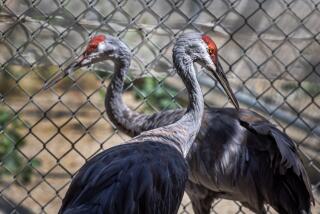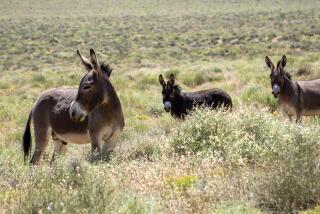Wild Burros’ Hoofs Fly as They Get Helping Hand
RAMONA — The cowboy was pinned amid a group of wild burros, and his wide-brimmed hat couldn’t mask the look of concern on his face.
“Don’t kick,” he pleaded, his fist clenching a clump of burro mane. “Please don’t kick.”
The cowboy escaped without harm. And by the end of the day, he and his colleagues had accomplished what they came to do: trim the hoofs of 40 uncooperative, contrary and downright ornery wild burros. Most suffered scrapes and cuts, but no one was injured seriously.
After it was all over, Michael Cline, a horse dealer from Bonita, summed up the burros’ attitude: “They were biting, kicking and striking.”
The four-hour effort, conducted Sunday by volunteer labor at a ranch here, is part of a much broader program to save the West’s wild burros--the noble descendant of the pack animals that assisted Spanish explorers, American frontiersmen and other settlers of the rugged terrain west of the Mississippi.
The 40 burros here are among about 6,000 that have been taken out of Death Valley National Monument in the past three years, according to the Fund for Animals, a New York-based organization that initiated the operation. The group operates a five-acre ranch in Ramona where some of the burros are housed along with 200 goats rescued from San Clemente Island and 100 dogs and cats awaiting adoption as pets.
The rescue effort is viewed as a life-saving alternative: Although federal law protects wild burros and horses, Donna Gregory, the Fund’s regional director here, noted that the law also allows for the removal of animals that are overgrazing federal lands.
“They would have been removed with bullets,” Gregory said.
Most of the 6,000 wild burros removed from Death Valley have already been adopted by citizens from Maine to California, she said. The hope is that the 40 now staying in Ramona will also soon be adopted, leaving room for the 100 additional burros that the Fund anticipates rescuing from Death Valley in September.
Despite their cantankerous behavior Sunday, the burros soon make excellent pets, according to Fund officials and others. The wildness bred through generations of roaming the West’s deserts and mountainous back country apparently recedes quickly when they are adopted and well cared for in a domestic setting. Children love to ride them; horses like them as companions.
The price: $50 for males, $75 for females. Prospective adopters must agree to take two to ensure that the animals, accustomed to life in herds, don’t get lonely.
Fund officials are quick to point to the many letters received from satisfied people who have adopted the animals.
On Sunday, though, adoption wasn’t the central concern. Hoof-trimming was the order of the day.
In the wild, the naturally rocky terrain favored by the burros keeps the animals’ hoofs naturally trimmed. Corraled animals, however, must have their hoofs trimmed every few months; without the trimming, dirt and dead hoof material builds up. The result could cripple the animals.
Responding to the call, about 10 area horsemen came to Ramona to volunteer their services. Among them were some horse-handlers, horseshoers (known as farriers), cowboys, a veterinarian and others looking to lend a hand. They received no pay, but the beer and the buffet-style lunch of cold cuts were courtesy of the Fund.
“I got a phone call that they needed some help,” explained David Iverson, a shoer from Alpine.
The camaraderie was also an attraction.
“It’s a tight-knit community here in the horse business,” said horse dealer Cline. “They called, and everyone came for the fun of it.”
The burros were more begrudging about it. Consequently, the process was an arduous one.
First, the animals were herded in groups of about half a dozen into a 20-foot-long rectangular corral. There, the men generally worked on two animals at a time; typically, it took three to four men to hold the 500-pound critters while another worked on the hoofs with knives and clippers.
The corral was transformed into a living portrait of men, flies, dusts and burros laboring beneath the midday sun.
“This one’s a kicker!” was an oft-repeated warning.
Sometimes, the burros had to be wrestled to the ground before they would allow their hoofs to be handled. Always, men moved gingerly around the animals’ potent back legs.
After four hours, the job was done, and the burros were once again grazing on the ranch alongside the Spanish Andalusian goats rescued from San Clemente Island. Soon, the rigors of the effort were forgotten.
“They weren’t bad at all,” said Ed Frigo, a farrier from Poway who helped organize the outing.
The horsemen soon drifted up a hill to the Fund’s office, where food and drink awaited them. It had been a good day.
More to Read
Sign up for Essential California
The most important California stories and recommendations in your inbox every morning.
You may occasionally receive promotional content from the Los Angeles Times.










